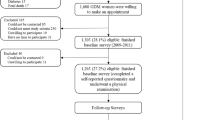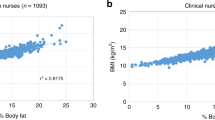Abstract
Objective:
To investigate differences in body composition between adolescent girls and mature women during pregnancy and the relationship to newborn anthropometry.
Design:
A prospective study.
Setting:
The antenatal clinic at the University Hospital of the West Indies, Kingston, Jamaica.
Subjects:
Four hundred and twenty-five women were invited to join the study. Three hundred and sixty-one women (84.9%) completed the study.
Interventions:
Study participants were divided into two groups: adolescents and mature women, who were all less than 15 weeks pregnant and had no systemic illness at the time of entry into the study. A questionnaire was administered which retrieved information on demographics, age, marital status, menstrual history, parity, socio-economic status, medical history and smoking/drinking habits. Anthropometric measurements including weight, height, triceps, biceps, subscapular and suprailiac skinfolds, as well as blood pressure measurements and urine analysis were performed at the first antenatal visit and repeated at 15, 25 and 35 weeks gestation. Anthropometric measurements of the newborn were performed at birth.
Results:
There were significant differences between anthropometry and skinfold thickness at the first antenatal visit between the adolescents and the mature women where the adolescents had lower measurements compared to the mature women. In the newborn anthropometry, the only significant difference seen was in the triceps skinfold thickness and the mid-upper arm circumference where the newborn of the adolescents had significantly smaller values (P=0.04; P=0.02, respectively). The percentage fat, fat mass and lean body mass were significantly lower in the adolescent compared to the mature women (P<0.0001), both at the first antenatal visit and at 35 weeks gestation. A greater gain was seen in these measurements throughout the pregnancy in the adolescents (P<0.0001). Linear regression analyses showed that the gain in lean body mass was the most important predictor of birth anthropometry.
Conclusion:
Body composition differs in pregnancy between adolescents and mature woman, and if adequate weight and lean body mass are attained, it impacts positively on birth size irrespective of age.
Sponsorship:
This study was supported by a grant from the Caribbean Health Research Council, 25A Warner Street, St Augustine, Trinidad, West Indies.
This is a preview of subscription content, access via your institution
Access options
Subscribe to this journal
Receive 12 print issues and online access
$259.00 per year
only $21.58 per issue
Buy this article
- Purchase on Springer Link
- Instant access to full article PDF
Prices may be subject to local taxes which are calculated during checkout
Similar content being viewed by others
References
Abrams BF, Laros RK (1986). Prepregnancy weight, weight gain, and birth weight. Am J Obstet Gynecol 154, 503–509.
Abrams B, Altman SL, Pickett KE (2000). Pregnancy weight gain: still controversial. Am J Clin Nutr 71, 1233S–1241S.
Conde-Agudelo A, Belizan JM, Lamers C (2005). Maternal–perinatal morbidity and mortality associated with adolescent pregnancy in Latin America: cross-sectional study. Am J Obstet Gynecol 192, 342–349.
Durnin JVGA, Rahaman MM (1967). The assessment of the amount of fat in the human body from measurements of skinfold thickness. Br J Nutr 21, 681–689.
Forsum E, Sadurskis A, Wager J (1988). Resting metabolic rate and body composition of healthy Swedish women during pregnancy. Am J Clin Nutr 47, 942–947.
Fraser AM, Brockert JE, Ward RH (1995). Association of young maternal age with adverse reproductive outcomes. N Engl J Med 332, 1113–1117.
Harrison GG, Buskirk ER, Lindsay Carter JE, Johnston FE, Lohman TG, Pollack ML et al. (1988). Skinfold thicknesses and measurement Techniques. In: Lohman TG, Roche AF, Martorell R (eds). Anthopometric Standardization Reference Manual. Human Kinetics Books: Champaign, IL,. pp 55–70.
Jackson J, Eggleston E, Lee A, Hardee K (1997). Reproductive knowledge, attitudes and behaviour among young adolescents in Jamaica. Soc Econ Stud 46, 95–109.
Kramer MS (1987). Determinants of low birth weight: methodological assessment and meta-analysis. Bull World Health Organization 65, 663–737.
Linne Y, Dye L, Barkeling B, Rossner S (2003). Weight development over time in parous women – the SPAWN study – 15 years follow-up. Int J Obes Relat Metab Disord 27, 1516–1522.
Mardones-Santander F, Salazar G, Rosso P, Villarroel L (1998). Maternal body composition near term and birth weight. Obstet Gynecol 91, 873–877.
McCarthy EA, Strauss BJ, Walker SP, Permezel M (2004). Determination of maternal body composition in pregnancy and relevance to perinatal outcomes. Obstet Gynecol Surv 59, 731–742.
Morris L, Sedivy V, Friedman JS, McFarlane CP (1995). Contraceptive Prevalence Survey, Jamaica 1993. Volume IV: Sexual Behaviour and Contraceptive Use among Young Adults. US Department of Health and Human Services, Public Health Service, Centers for Disease Control and Prevention: Atlanta, GA.
Naeye RL (1981). Teenaged and pre-teenaged pregnancies: consequences of the fetal maternal competition for nutrients. Pediatrics 67, 146–150.
Presley LH, Wong WW, Roman NM, Amini SB, Catalano PM (2000). Anthropometric estimation of maternal body composition in late gestation. Obstet Gynecol 96, 33–37.
Scholl TO, Hediger ML, Khoo C-S, Healey MF, Rawson NL (1991). Maternal weight gain, diet and infant birth weight: correlations during adolescent pregnancy. J Cin Epidemiol 44, 423–428.
Scholl TO, Hediger ML, Schall JI, Khoo C-S, Fischer RL (1994). Maternal growth during pregnancy and the composition for nutrients. Am J Clin Nutr 60, 183–188.
Seidman DS, Ever-Hadini P, Stevenson DK, Slater PE, Harlap S, Gale R (1988). Birth order and birth weight reexamined. Obstet Gynecol 72, 158–162.
Siri WE (1961). Body composition from fluid spaces and density: analysis of methods. In: Brojek J, Henschel A (eds). Techniques for Measuring Body Composition. National Academy of Sciences, National Research Council: Washington, DC, pp 223–244.
Stevens-Simon C, McAnarney ER, Roghmann KJ (1993). Adolescent gestational weight gain and birth weight. Pediatrics 92, 805–809.
Strobino DM, Ensminger ME, Kim YJ, Nanda J (1995). Mechanisms for maternal age differences in birth weight. Am J Epidemiol 142, 504–514.
Thame M, Wilks R, Matadial L, Forrester TE (1999). A comparative study of pregnancy outcome in teenage girls and mature women. West Indian Med J 48, 69–72.
Thame M, Wilks RJ, McFarlane-Anderson N, Bennett FI, Forrester TE (1997). Relationship between maternal nutritional status and infant's birth weight and body proportions at birth. Eur J Clin Nutr 51, 134–138.
The Statistical Institute of Jamaica (1996). Demographic Statistics 1995. The Statistical Institute of Jamaica: Kingston.
Villar J, Cogswell M, Kestler E, Castillo P, Menendez R, Repke JT (1992). Effect of fat and fat-free mass deposition during pregnancy on birth weight. Am J Obstet Gynecol 167, 1344–1352.
Author information
Authors and Affiliations
Corresponding author
Rights and permissions
About this article
Cite this article
Thame, M., Trotman, H., Osmond, C. et al. Body composition in pregnancies of adolescents and mature women and the relationship to birth anthropometry. Eur J Clin Nutr 61, 47–53 (2007). https://doi.org/10.1038/sj.ejcn.1602484
Received:
Revised:
Accepted:
Published:
Issue Date:
DOI: https://doi.org/10.1038/sj.ejcn.1602484
Keywords
This article is cited by
-
Mitochondrial inefficiency in infants born to overweight African-American mothers
International Journal of Obesity (2018)
-
Glucose kinetics and pregnancy outcome in Indian women with low and normal body mass indices
European Journal of Clinical Nutrition (2009)



